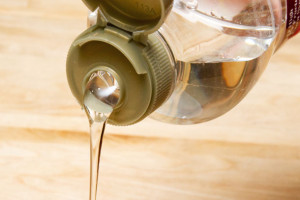Inverted or invert sugar syrup is a mixture of glucose and fructose; it is obtained by splitting sucrose into these two components.
Contents
Uses
- Honey is a mixture (principally) of glucose and fructose, giving it similar properties to invert syrup. This gives it the ability to remain liquid for long periods of time.
- Jam, when made, produces invert sugar during extensive heating under the action of the acid in the fruit.
- Golden syrup is a syrup of approximately 56% invert syrup, 44% sucrose.
- Fondant filling for chocolates is unique in that the conversion enzyme is added, but not activated before the filling is enrobed with chocolate. The very viscous (and thus formable) filling then becomes less viscous with time, giving the creamy consistency desired.
- Cigarettes use inverted sugar as a casing to add flavour.
- Alcoholic beverage manufacturers often add invert sugar in the production of drinks like gin, beer and sparkling wines for flavouring. Candi sugar is a type of invert sugar used in the brewing of Belgian-style beers to boost alcohol content without drastically increasing the body of the beer; it is frequently found in the styles of beer known as dubbel and tripel.
- Cadbury Creme Eggs are filled with inverted sugar syrup produced by processing fondant with invertase
Benefits
- Invert sugar beneficial in confectionary preparations (giving them added moisture) and in the preparation of sorbets and ice cream since it has the ability for controlling crystallization and creating a smoother mouth feel.
-
Cost effective sweetnessDue to the mix of sugars – sucrose, glucose and fructose and the sweetness synergy between sucrose and fructose, Medium invert delivers an increased sweetness for the same solids when compared to sucrose alone. This extra sweetness is useful in fruit flavoured drinks where around 20% less carbohydrate sweetener can be used than would be the case with a standard invert.
-
Keeps food moister, fresherInvert syrup has a high affinity for water, so an invert syrup (a ‘humectant’) is often used to keep products moist and extend their shelf life. This additional moisture retention is especially important in low fat baked goods such as cakes, soft cookies and bread rolls, since these products can become dry and stale much quicker than their full fat counterparts. Invert syrup can also be used in place of glycerol as the humectant in cakes, where it brings additional benefits such as enhanced fruit flavours, extra sweetness, enhanced colour and improved flavour development during cooking.
-
Preservation – water activity reduction (Aw)If a product has a high ‘water activity’ it may be more prone to microbial contamination which in turn may reduce the shelf life. The increased number of molecules in an invert syrup causes an increase in osmotic pressure and inhibits microbial growth so it acts as a more effective preservative.
-
Freezing point depressionUse of an invert syrup can also lower the freezing point of solution and prevent theformation of large ice crystals. This is ideal for many products, including:• soft, easy-scoop ice creams and sorbets• baked goods held in frozen storage prior to being released to retailers• freeze/thaw-stable fillings of cakes and toppings
-
Minimises crystallisationInvert syrups can slow down and minimise crystallisation. They can, for example, keep icings and fondants soft and smooth throughout their shelf life. This ability is also useful in low temperatures – for example, where softness must be retained during freezing. Some jam recipes with low acid fruits produce very little sucrose inversion during boiling. So the addition of an invert at the start of the boil can prevent the jam from crystallising.
-
Flavour enhancementThe fructose in an invert syrup has a natural synergy with acid and fruit flavours and therefore can enhance these flavours in applications such as:• soft drinks• baked goods containing fruit• fruit-flavoured confectionery
-
Flavour and colour developmentInvert syrups have a higher tendency to develop colour and therefore enhance colour development during the manufacture of:• toffees• caramels• fudges
-
Texture softeningInvert syrup’s natural affinity for water and its ability to reduce crystallisation can give products such as the following a soft, pliable texture and extended shelf life:• American style cookies• sweet pancakes• hamburger buns• liquorice allsorts
-
StabiliserInverts are used extensively in the production of elixirand cough linctuses giving:• smooth mouth-feel• palatable delivery• suspension of active ingredients
-
Increases viscosityHigh brix inverts are useful:• as a binding syrup in cereal bars• to plasticise icings• to reduce the viscosity offondant creams
Cautions
- These days many people are moving away from artificial sugars as many studies have shown that they can have side effects, therefore natural sugars like regular white, brown and invert sugars have been gaining more and more popularity in this segment of customers.
Interactions
- None are recorded as the syrup is commonly used. Please talk to your doctor.
Other names
inverted sugar syrup
References
Source: Wikipedia, https://en.wikipedia.org/wiki/Inverted_sugar_syrup
Science of Cooking, http://www.scienceofcooking.com/what_are_inverted_sugars.htm
Apmultiproducts, https://apmultiproducts.wordpress.com/2011/08/05/benefits-of-invert-sugar-syrup/
Invertsugarsyrup, http://www.invertsugarsyrup.com/golden.php

